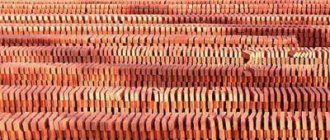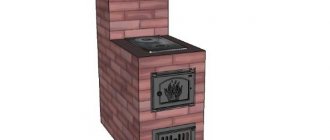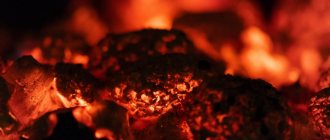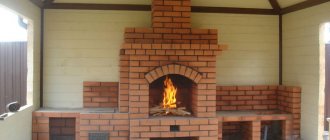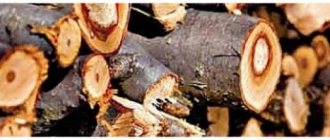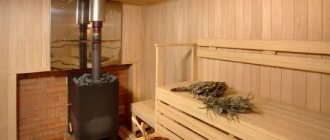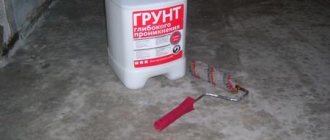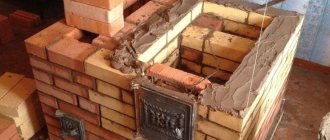Brick making techniques
Bricks can be made in two ways: semi-dry and dry pressing and by plastic molding. The difference between these methods is not great and lies only in the unequal amount of moisture contained in the raw material mass.
The second manufacturing method has become more widespread, but there is a tendency that semi-dry and dry pressing may eventually replace the plastic forming method.
Using the plastic formation method, it is possible to obtain both solid and hollow bricks. The technologies for their manufacture are almost the same, but for hollow bricks the clay is prepared more carefully.
Brick making can be divided into the following stages:
- Preparation of raw materials.
- Formation of raw brick.
- Pre-drying of bricks.
- Firing at high temperature.
Each technological stage requires compliance with certain requirements. Before you start firing bricks, you should carefully prepare it: starting from the preparation of raw materials and ending with natural drying, otherwise defects cannot be avoided.
Attention: Defects are also possible at the final, very important stage of brick manufacturing - firing, if you avoid temperature conditions.
Brick firing
So:
- Raw brick, after preliminary drying, has from 8 to 12% moisture content, which requires a certain amount of drying in the oven. Then the temperature is gradually raised to 500-800ºС, as a result of which irreversible processes occur inside the raw material.
- When the temperature increases to 200ºС, organic impurities and various additives evaporate from the brick. After this, the temperature is raised to 300-350ºС and the raw brick is kept at this temperature until all the carbon burns out and only after that the temperature begins to be raised to 800ºС. At this temperature, the material begins to change its structure. The brick is kept at this temperature for some time, after which the temperature begins to gradually decrease.
- Firing time can range from 6-48 hours. During this time, the brick acquires unique characteristics: high strength, excellent thermal insulation properties, resistance to moisture, resistance to fluctuations and temperature changes.
Types of brick kilns
Currently, there are several types of brick kilns that can be used in the production of bricks, depending on many factors and conditions.
A lot depends on the scale of the planned production, as well as the availability of a particular energy base. After all, bricks can be fired with gas, electricity, coal or wood. The design of the furnace will depend on this.
Ring furnace
The ring kiln for firing bricks is a continuous-functioning structure and is a closed channel for firing. This complex mechanism is used not only for annealing bricks, but also for heat treatment of various metal products, in the production technology of pipes, wheels and tires for railway transport.
As a rule, such devices have high performance and efficiency.
Photo of an industrial ring brick kiln
So:
- The design of the ring furnace is that the raw brick stands still, and the fire zone constantly moves.
- The firing chamber of such furnaces has the shape of an ellipse, on the sides of which there are windows designed for loading and unloading the product.
- Firing technology comes down to a sequence of processes that follow one after another, from one window to another.
- Each window represents a separately constructed chamber. As soon as the fire passes through the entire chamber, it means that the process of firing the brick in this chamber is completed and the annealing of the brick located in the next chamber begins.
- The firing process in such kilns can take from 3 to 4 days, despite the cost-effectiveness. Unfortunately, the process of loading and unloading cameras is quite labor-intensive.
- In such furnaces it is possible to use various types of energy carriers, including low-grade ones, such as milled peat, anthracite chips, various fuel wastes, and at the same time, you can easily switch from one type of fuel to another.
Attention: Modern manufacturers prefer tunnel kilns, which allow automation of the basic processes of loading and unloading bricks.
Operating principle of a ring furnace
In such kilns, the fire falls directly on the brick intended for firing. The furnace is equipped with a central smoke channel, which runs along the perimeter of the ring furnace and goes directly into the firing zone.
Attention: The firing chamber does not have a permanent and clearly defined partition, therefore, the firing oven is divided into chambers, very arbitrarily.
- The design of the furnace allows you to connect the required firing channel to the central smoke channel at any time by reorienting the transfer metal box.
- Hot flue gases from the firing chamber, before entering the central chimney, pass through chambers with raw bricks and dry it. Gases enter the central chimney cooled to 120-150ºС. This technology makes it possible to effectively use the temperature of the coolant: in addition to firing the brick, it is possible to dry the raw brick.
- These kilns effectively use the temperature of the cooling brick. This happens as follows: the air that enters the firing chamber passes through the chambers with the cooling brick. Thus, the air arrives already heated, which means saving some of the energy that would certainly be spent on heating the incoming air.
Attention: If the kiln is fully loaded, then at the beginning of firing the product is constantly present, and 2-3 chambers remain free through which bricks are loaded and unloaded.
Tunnel oven
Tunnel kiln for firing bricks
Tunnel kiln for firing bricks is most often used for continuous production. It is simpler in its design and therefore has gained great popularity.
So:
- Here the name speaks for itself: a tunnel kiln consists of a tunnel from 5 to 150 meters long and up to 2.7 meters high, with a rail bed laid inside.
- A train with trolleys loaded with bricks moves along the rails. The movement mechanism can be different: hydraulic and screw pushers, moved by cable systems, etc. The trolleys are made of thick metal and have a special refractory lining on which bricks intended for firing are laid.
- The kiln has one entrance and one exit, located at the ends of the tunnel. A special mechanism is installed at the entrance and exit to ensure the tightness of the furnace during the rolling in and rolling out of the trolleys. The mechanism operates automatically, which allows you to save some of the money spent on energy.
- In addition, along the entire length of the tunnel there is a sand barrier that prevents combustion products from penetrating into the space under the trolleys.
The tunnel kiln for firing bricks has a conditional division into zones:
- Preheating zone.
- Firing zone.
- Gradual cooling zone.
Attention: The firing zone of the tunnel kiln is equipped with special burners that supply heated gas to the firing zone. Natural gas is used as fuel, which can ensure the uninterrupted functioning of such devices. It is also possible to use solid fuel, but such stoves have a slightly different design.
- In the firing chamber, the temperature of the gases rises to 920-980ºС with a firing time of 24 to 48 hours and a productivity of up to 70 thousand bricks. In this case, it all depends on the type of brick and technological buildings.
Firing process
Raw brick is laid on the lining of the trolley in a layer about 1 meter thick, which will prevent deformation of the fired products. When moving, trolleys with bricks slowly pass through 3 main zones of the tunnel kiln: heating zones, firing zones, cooling zones. The speed of movement is chosen in such a way that the firing of bricks occurs according to the technology.
The firing technology is controlled using computer technology, which allows:
- Monitor the firing mode.
- Control the temperature in all three zones.
- Monitor air pressure.
- Select the firing mode depending on the quality of the raw brick.
- Possibility to control finished products automatically.
Raw bricks are loaded onto trolleys manually, and finished bricks are unloaded from the kiln using a special mechanism, which carries out quality control.
- Air is supplied to the furnace using fans, and exhaust gases are removed from the furnace using smoke exhausters. Both systems have their own recirculation channels that help heat the air mass entering the firing zone and cool it after passing through the firing zone and entering the preheating zone. This makes it possible to optimally use the energy of the tunnel kiln.
- All exhaust gases are removed from the furnace operating area using air ducts and smoke exhausters.
Raw brick production
There are two methods for producing bricks from clay:
- unfired (so-called raw brick),
- burned.
Made using technology and from good clay, unfired building material can compete almost equally with fired construction material. It is successfully used in the construction of small buildings on the site: one-story buildings, ancillary buildings - sheds, saunas, etc. Let's look at the method of producing raw bricks.
Making molds (manual and mechanical)
The first option is to make it with improvised means. We will need the dimensions of the forms that need to be made, usually these are the dimensions of an ordinary brick 250-120x62 mm. The material for them can be boards with a thickness of about 25 mm; it will also be necessary to use additional sheets of plywood.
The inner surface of the mold is smooth. To form voids in the brick, the lids must be made with protrusions. The protrusions are made with a slope to facilitate the process of removing the finished product.
The components of the mold are nailed together with nails 50–60 mm long, ensuring free removal of the top cover. We recommend making several identical molds - this will intensify your small production.
The second option is if you are planning a large-scale construction project, it is better to rent a machine for fast and efficient brick production.
Loading forms
We wet the inner parts of the molds with water before loading the mixture, and then sprinkle them with fine dust or cement - this will make removing the products much easier. Fill the molds, shaking occasionally so that the mixture fills the entire volume. The protruding excess is cut off with any convenient metal device.
Closing the mold with the top lid, let it sit for some time. We remove the lid, turn the mold over and, carefully lifting it up, remove the contents to the platform for drying.
Drying
Drying workpieces is a rather complex and important process. They should be dried on racks that have a canopy to protect the blocks from solar radiation and precipitation.
If drying is carried out in a utility room, for example, in a barn, then the material must be kept indoors for three days, and then ventilation must be organized.
If you plan to dry outside, then first prepare the area for placing the bricks - you need to make a wooden floor or fill the area with dry sand. As the liquid evaporates, the workpieces shrink, resulting in a loss of up to 15% of the original volume.
Important: the outside air temperature when drying outside must be at least 10 °C.
The duration of drying can be influenced by many atmospheric factors: temperature, humidity and the speed of movement of air masses. The process is long and can last from 6 to 15 days. The unfired brick is ready, you can begin construction work.
Important: the resistance of bricks obtained in this way to water is very low. This must be taken into account when constructing buildings.
Is it possible to secure such a brick? There are a number of standard methods that help protect the material from moisture:
- the roof overhang must be at least 0.6 m long,
- door and window openings must be located at a distance of at least 1.5 m from the corners of buildings,
- the seams of the masonry must be well tied,
- finished walls must be plastered; they can also be lined with facing bricks or other modern building materials.
Firing bricks at home
As a rule, industrial production of bricks is characterized by large mass production, which is not always economically profitable.
Attention: Such production must be 100% loaded in order for there to be a tangible economic effect. Currently, there is a tendency to move from large volumes of production to small volumes, when high-quality control of the products is possible.
- If desired, you can organize brick firing at home. This option is suitable when you need a little brick, and the brick offered by the manufacturer does not have the appropriate quality. To do this, you can take a regular 200 liter barrel and cut out the bottom and top of it.
- In this case, you can get by with a very ordinary fire, but first you need to dig a hole, about 50 cm deep. Above this hole, a barrel is installed on special supports, ensuring the height of the barrel rolls is about 20 cm above ground level. At the bottom of the barrel there is a metal grate on which the brick will be stacked.
- After the barrel is filled with brick, it is advisable to close it with a lid to reduce energy loss. In the process of filling the barrel, you should pay attention to leaving a gap of about 5 mm between each brick, then there will be a more uniform heating of all bricks.
- Depending on the characteristics of the clay solution, firing can last for 20 hours.
- At the same time, this time should be divided into three parts so that each part of the time corresponds to one technological cycle: one part of the time is allocated for a gradual increase in temperature, the other part of the time for firing and the third part of the time for slow cooling. Only in this case can you obtain a high-quality final product.
Device
In its design, this installation is very reminiscent of a railway tunnel. This is where its name comes from. Processed materials and raw materials are moved inside the furnace using special trolleys on rails, an electrically driven conveyor belt or hand trucks. In several zones of the tunnel oven they are exposed to different temperatures.
The design of the oven is a brick or metal chamber of an elongated type. Its length may vary, depending on the tasks performed and the type of installation. The following can be used as fuel:
- Solid fuel (coal).
- Gaseous fuel.
- Liquid fuel (fuel oil).
Fuel is supplied to the combustion chamber using special superchargers. Heated air enters the working space of the furnace. Depending on the operating mode, characteristics and purpose of the installation, the temperature of the air mixture can be different, from 100 to 2000 degrees Celsius. The entire tunnel can be divided into three main zones:
- Heating of raw materials and materials.
- Basic processing.
- Cooling of finished products.

